Abstract
During daily 3-hr sessions, 5 rhesus monkeys drank drug solutions and water that were concurrently available. The drug solutions were: 1 milligram per milliliter (mg/mL) pentobarbital (2 monkeys), 1 mg/mL pentobarbital plus 0.5% ethanol (1 monkey), 1 mg/mL pentobarbital plus 1% ethanol (1 monkey), and 8% ethanol (1 monkey). The drug solution and water were available under identical two-component tandem fixed-ratio continuous-reinforcement N schedules. Two variables were manipulated: the size of the fixed-ratio component and the number of liquid deliveries (N) in the second component. Deliveries of the drug solution maintained higher rates of responding than did deliveries of the drug vehicle, water. The number of drug deliveries per session increased with increases in the number of deliveries per fixed ratio and decreased with increases in fixed-ratio size. Analysis of the results in terms of the proportion of deliveries to responses showed that the number of drug deliveries per session was directly related to the size of this quotient. Finally, when fixed-ratio size was repeatedly doubled, the following orderly relationship emerged: The greater the number of available drug deliveries per fixed ratio, the less was the percent decrease in the number of fixed ratios completed per session. It was concluded that increases in the number of liquid deliveries per fixed ratio resulted in increases in reinforcing efficacy.
Full text
PDF
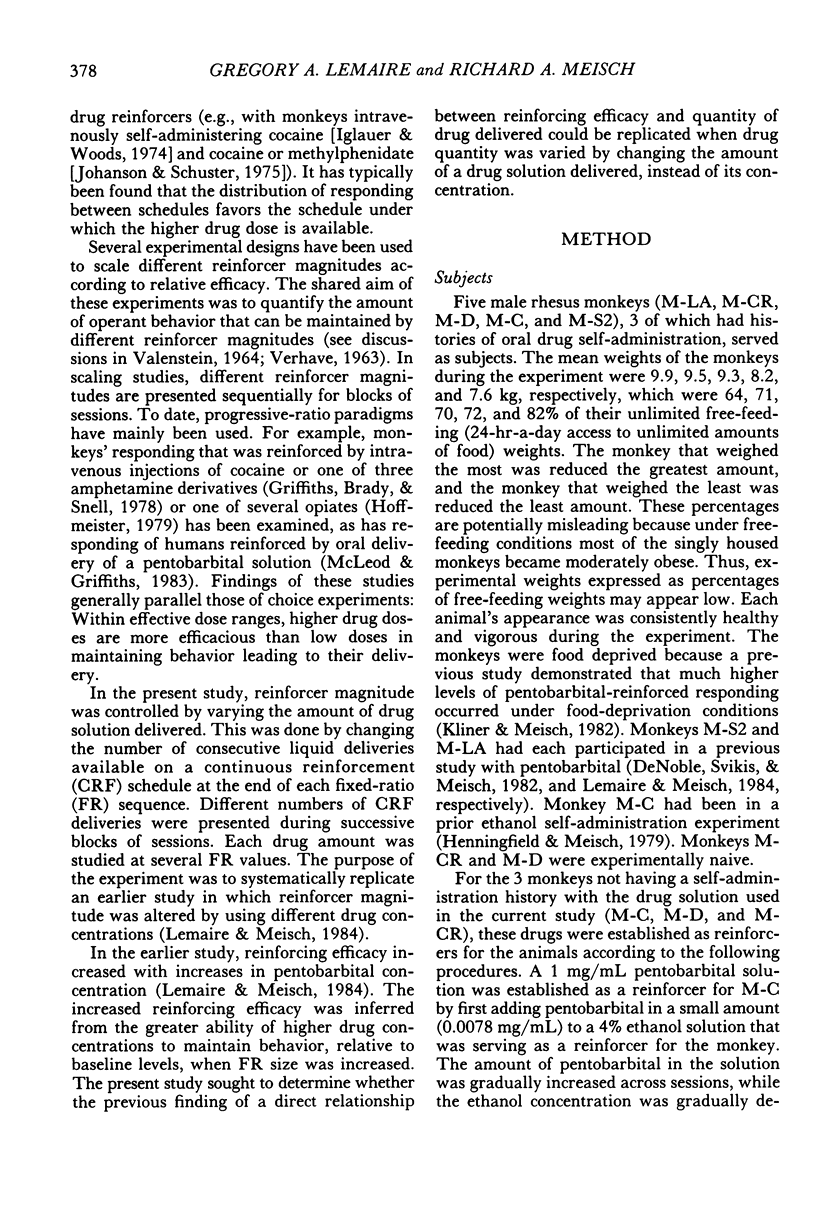



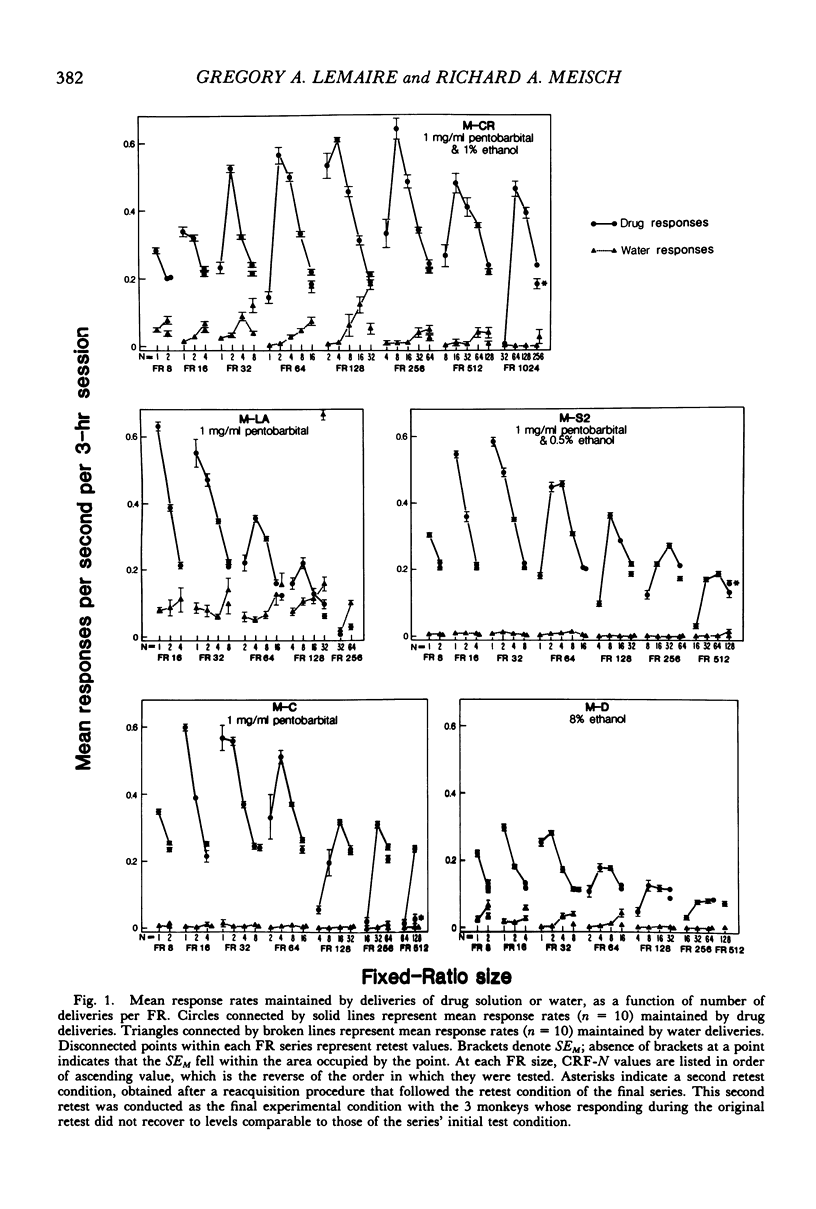
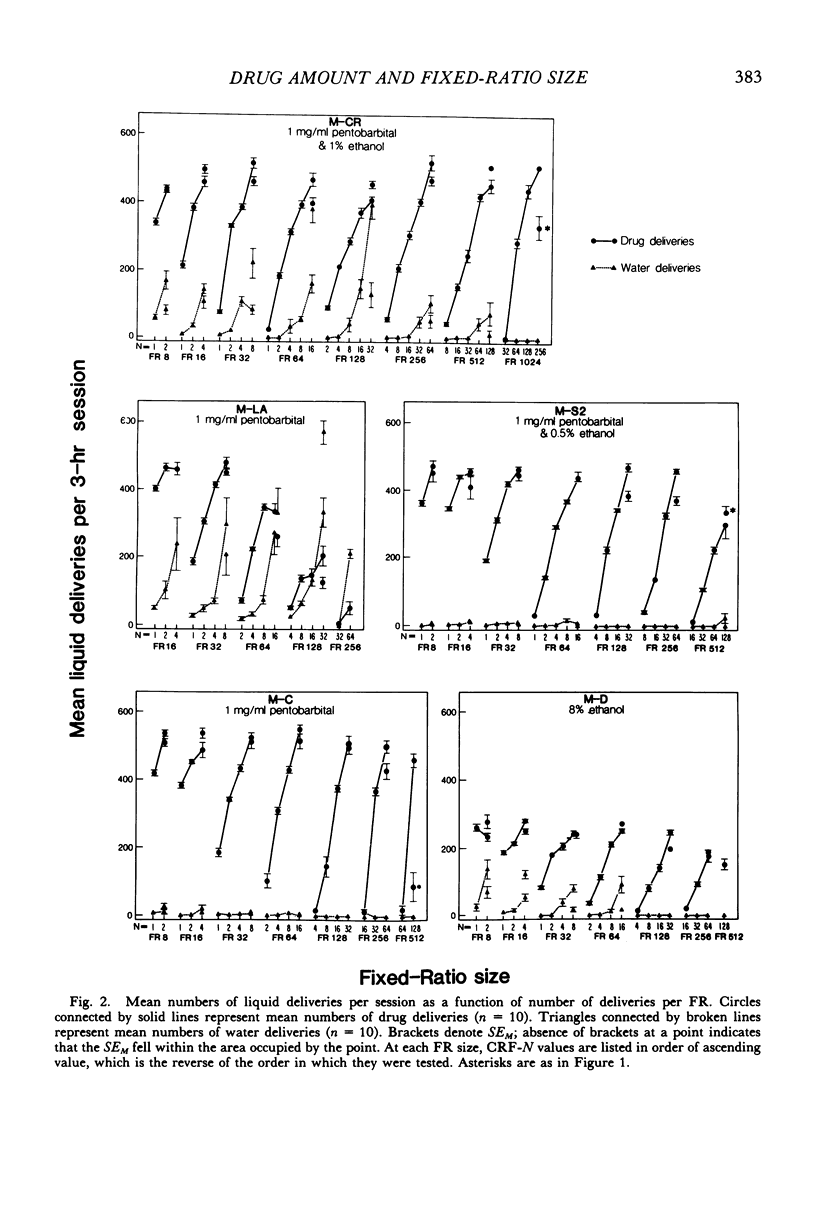

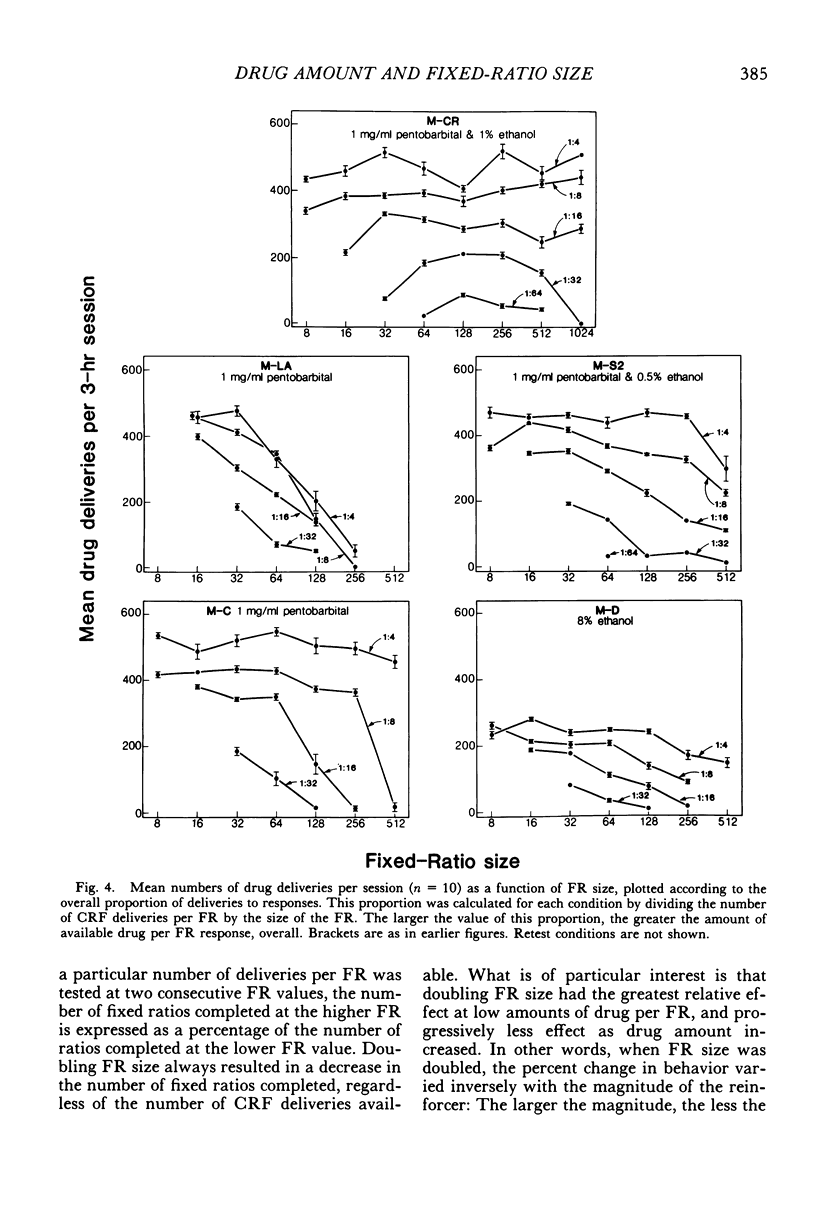
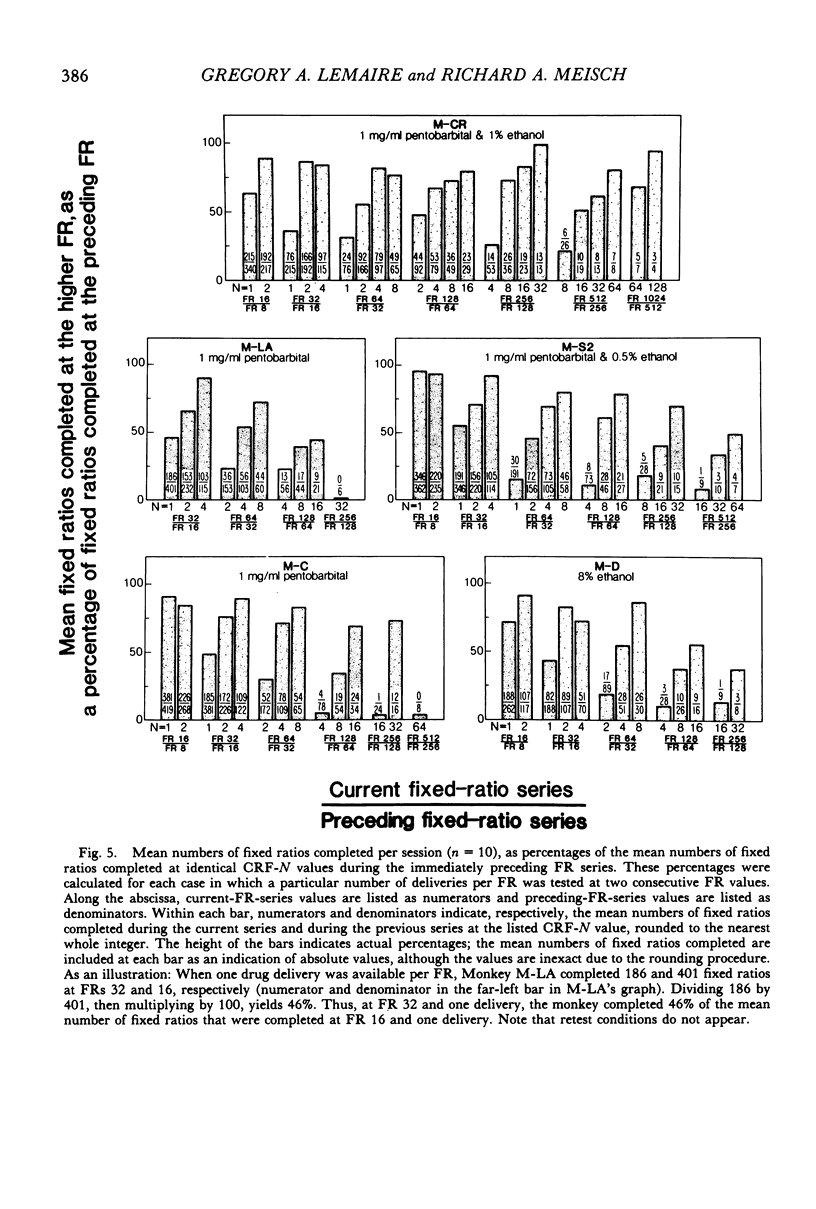
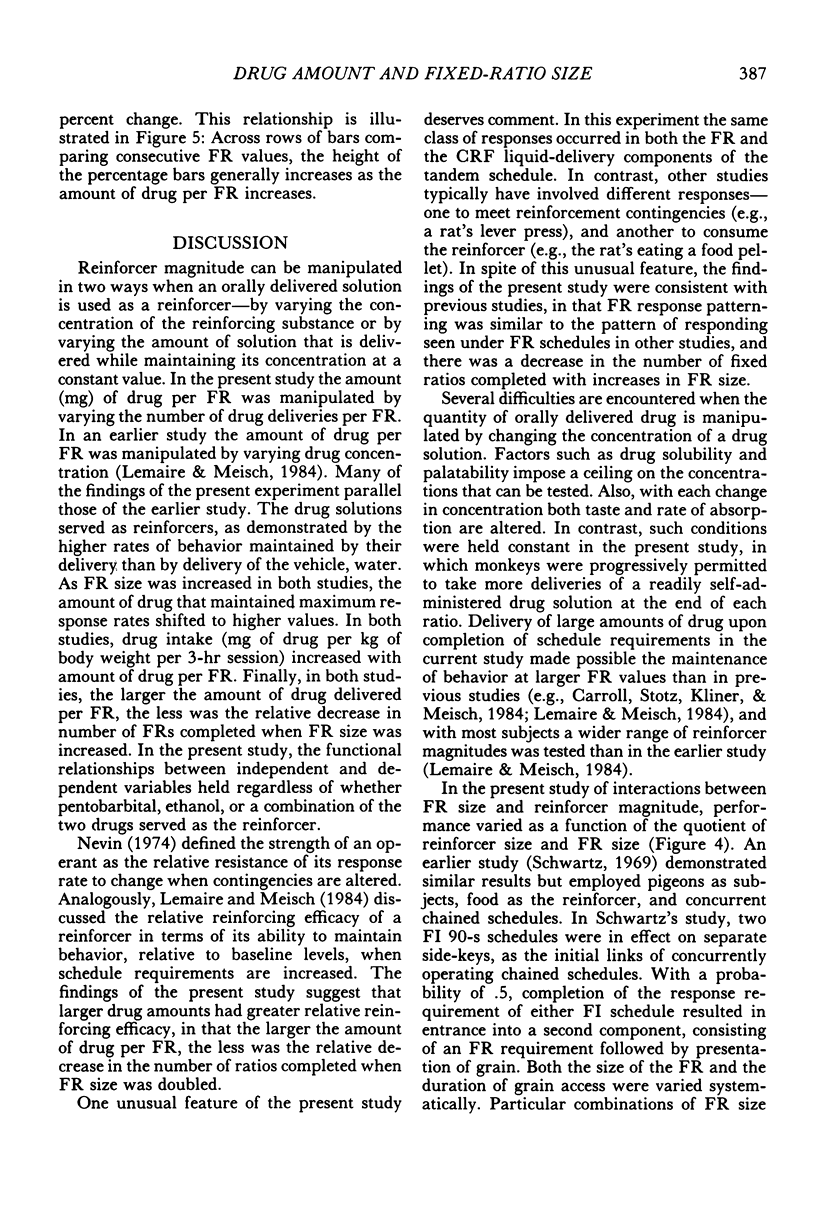
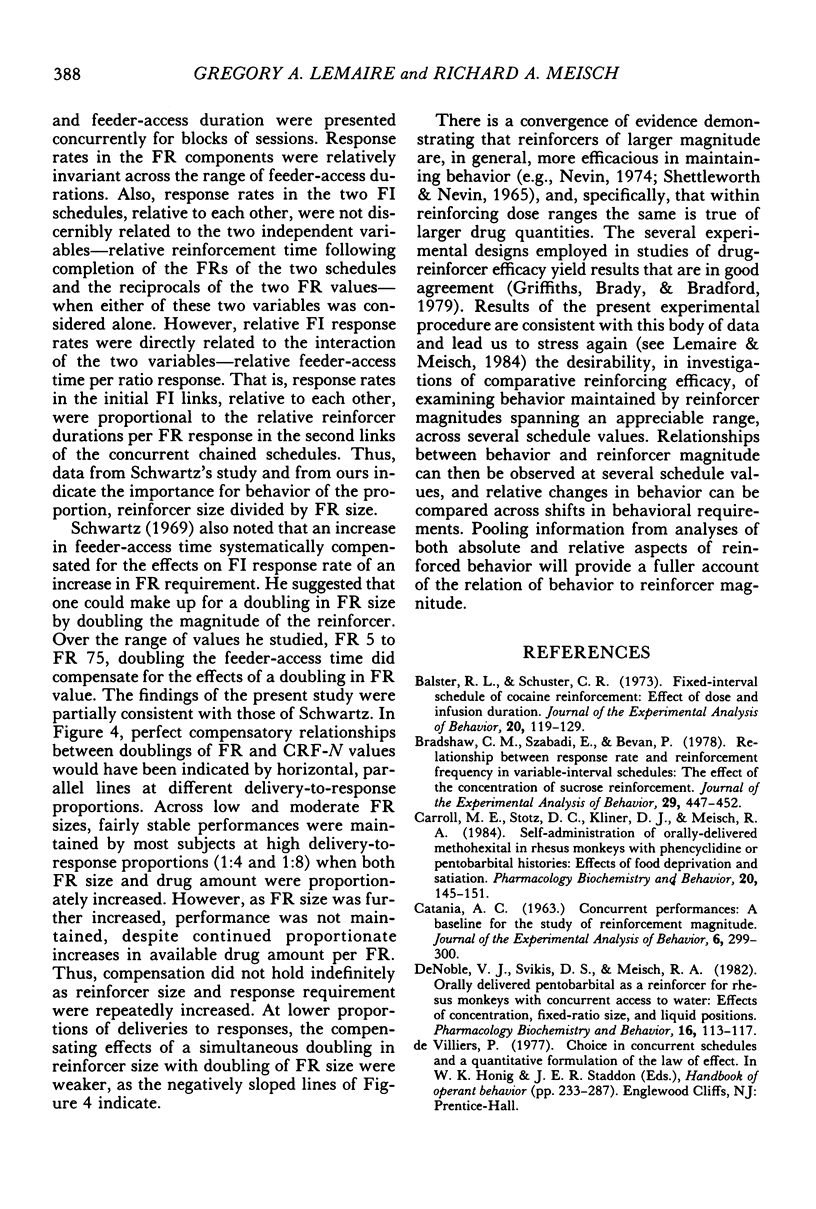
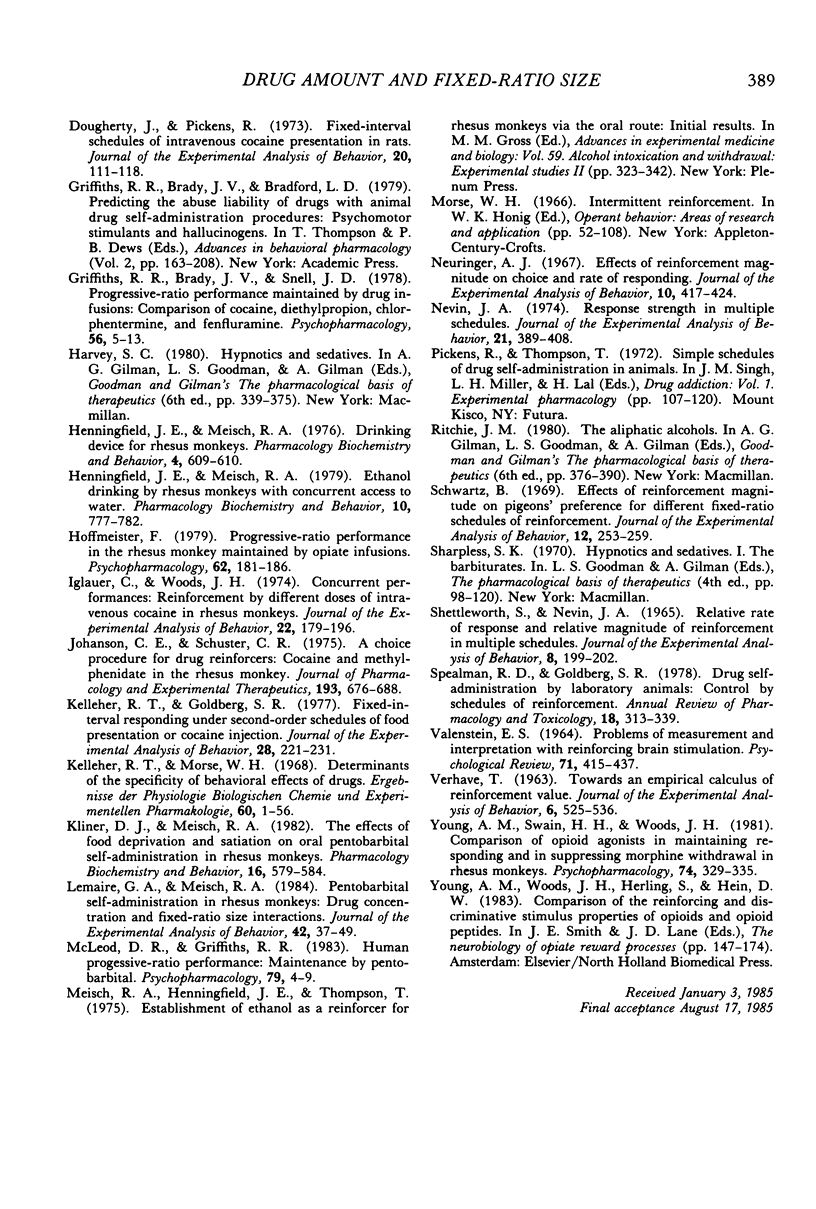
Selected References
These references are in PubMed. This may not be the complete list of references from this article.
- Balster R. L., Schuster C. R. Fixed-interval schedule of cocaine reinforcement: effect of dose and infusion duration. J Exp Anal Behav. 1973 Jul;20(1):119–129. doi: 10.1901/jeab.1973.20-119. [DOI] [PMC free article] [PubMed] [Google Scholar]
- Bradshaw C. M., Szabadi E., Bevan P. Relationship between response rate and reinforcement frequency in variable-interval schedules: the effect of the concentration of sucrose reinforcement. J Exp Anal Behav. 1978 May;29(3):447–452. doi: 10.1901/jeab.1978.29-447. [DOI] [PMC free article] [PubMed] [Google Scholar]
- CATANIA A. C. Concurrent performances: a baseline for the study of reinforcement magnitude. J Exp Anal Behav. 1963 Apr;6:299–300. doi: 10.1901/jeab.1963.6-299. [DOI] [PMC free article] [PubMed] [Google Scholar]
- Carroll M. E., Stotz D. C., Kliner D. J., Meisch R. A. Self-administration of orally-delivered methohexital in rhesus monkeys with phencyclidine or pentobarbital histories: effects of food deprivation and satiation. Pharmacol Biochem Behav. 1984 Jan;20(1):145–151. doi: 10.1016/0091-3057(84)90115-1. [DOI] [PubMed] [Google Scholar]
- DeNoble V. J., Svikis D. S., Meisch R. A. Orally delivered pentobarbital as a reinforcer for rhesus monkeys with concurrent access to water: effects of concentration, fixed-ratio size, and liquid positions. Pharmacol Biochem Behav. 1982 Jan;16(1):113–117. doi: 10.1016/0091-3057(82)90021-1. [DOI] [PubMed] [Google Scholar]
- Dougherty J., Pickens R. Fixed-interval schedules of intravenous cocaine presentation in rats. J Exp Anal Behav. 1973 Jul;20(1):111–118. doi: 10.1901/jeab.1973.20-111. [DOI] [PMC free article] [PubMed] [Google Scholar]
- Griffiths R. R., Brady J. V., Snell J. D. Progressive-ratio performance maintained by drug infusions: comparison of cocaine, diethylpropion, chlorphentermine, and fenfluramine. Psychopharmacology (Berl) 1978 Jan 31;56(1):5–13. doi: 10.1007/BF00571401. [DOI] [PubMed] [Google Scholar]
- Henningfield J. E., Meisch R. A. Drinking device for rhesus monkeys. Pharmacol Biochem Behav. 1976 May;4(5):609–610. doi: 10.1016/0091-3057(76)90204-5. [DOI] [PubMed] [Google Scholar]
- Henningfield J. E., Meisch R. A. Ethanol drinking by rhesus monkeys with concurrent access to water. Pharmacol Biochem Behav. 1979 May;10(5):777–782. doi: 10.1016/0091-3057(79)90332-0. [DOI] [PubMed] [Google Scholar]
- Hoffmeister F. Progressive-ratio performance in the rhesus monkey maintained by opiate infusions. Psychopharmacology (Berl) 1979 Apr 11;62(2):181–186. doi: 10.1007/BF00427134. [DOI] [PubMed] [Google Scholar]
- Iglauer C., Woods J. H. Concurrent performances: reinforcement by different doses of intravenous cocaine in rhesus monkeys. J Exp Anal Behav. 1974 Jul;22(1):179–196. doi: 10.1901/jeab.1974.22-179. [DOI] [PMC free article] [PubMed] [Google Scholar]
- Johanson C. E., Schuster C. R. A choice procedure for drug reinforcers: cocaine and methylphenidate in the rhesus monkey. J Pharmacol Exp Ther. 1975 May;193(2):676–688. [PubMed] [Google Scholar]
- Kelleher R. T., Goldberg S. R. Fixed-interval responding under second-order schedules of food presentation or cocaine injection. J Exp Anal Behav. 1977 Nov;28(3):221–231. doi: 10.1901/jeab.1977.28-221. [DOI] [PMC free article] [PubMed] [Google Scholar]
- Kelleher R. T., Morse W. H. Determinants of the specificity of behavioral effects of drugs. Ergeb Physiol. 1968;60:1–56. doi: 10.1007/BFb0107250. [DOI] [PubMed] [Google Scholar]
- Kliner D. J., Meisch R. A. The effects of food deprivation and satiation on oral pentobarbital self-administration in rhesus monkeys. Pharmacol Biochem Behav. 1982 Apr;16(4):579–584. doi: 10.1016/0091-3057(82)90419-1. [DOI] [PubMed] [Google Scholar]
- Lemaire G. A., Meisch R. A. Pentobarbital self-administration in rhesus monkeys: drug concentration and fixed-ratio size interactions. J Exp Anal Behav. 1984 Jul;42(1):37–49. doi: 10.1901/jeab.1984.42-37. [DOI] [PMC free article] [PubMed] [Google Scholar]
- McLeod D. R., Griffiths R. R. Human progressive-ratio performance: maintenance by pentobarbital. Psychopharmacology (Berl) 1983;79(1):4–9. doi: 10.1007/BF00433007. [DOI] [PubMed] [Google Scholar]
- Neuringer A. J. Effects of reinforcement magnitude on choice and rate of responding. J Exp Anal Behav. 1967 Sep;10(5):417–424. doi: 10.1901/jeab.1967.10-417. [DOI] [PMC free article] [PubMed] [Google Scholar]
- Nevin J. A. Response strength in multiple schedules. J Exp Anal Behav. 1974 May;21(3):389–408. doi: 10.1901/jeab.1974.21-389. [DOI] [PMC free article] [PubMed] [Google Scholar]
- SHETTLEWORTH S., NEVIN J. A. RELATIVE RATE OF RESPONSE AND RELATIVE MAGNITUDE OF REINFORCEMENT IN MULTIPLE SCHEDULES. J Exp Anal Behav. 1965 Jul;8:199–202. doi: 10.1901/jeab.1965.8-199. [DOI] [PMC free article] [PubMed] [Google Scholar]
- Schwartz B. Effects of reinforcement magnitude on pigeons' preference for different fixed-ratio schedules of reinforcement. J Exp Anal Behav. 1969 Mar;12(2):253–259. doi: 10.1901/jeab.1969.12-253. [DOI] [PMC free article] [PubMed] [Google Scholar]
- Spealman R. D., Goldberg S. R. Drug self-administration by laboratory animals: control by schedules of reinforcement. Annu Rev Pharmacol Toxicol. 1978;18:313–339. doi: 10.1146/annurev.pa.18.040178.001525. [DOI] [PubMed] [Google Scholar]
- VALENSTEIN E. S. PROBLEMS OF MEASUREMENT AND INTERPRETATION WITH REINFORCING BRAIN STIMULATION. Psychol Rev. 1964 Nov;71:415–437. doi: 10.1037/h0040694. [DOI] [PubMed] [Google Scholar]
- VERHAVE T. TOWARDS AN EMPIRICAL CALCULUS OF REINFORCEMENT VALUE. J Exp Anal Behav. 1963 Oct;6:525–536. doi: 10.1901/jeab.1963.6-525. [DOI] [PMC free article] [PubMed] [Google Scholar]
- Young A. M., Swain H. H., Woods J. H. Comparison of opioid agonists in maintaining responding and in suppressing morphine withdrawal in rhesus monkeys. Psychopharmacology (Berl) 1981;74(4):329–335. doi: 10.1007/BF00432741. [DOI] [PubMed] [Google Scholar]


